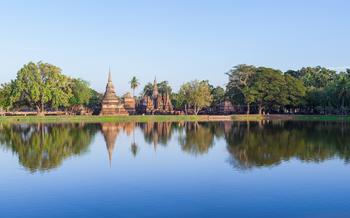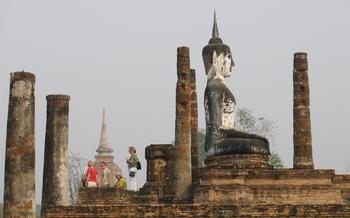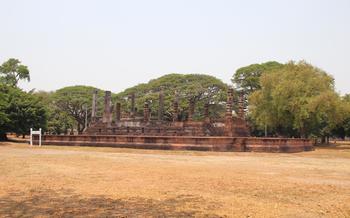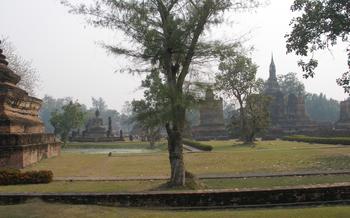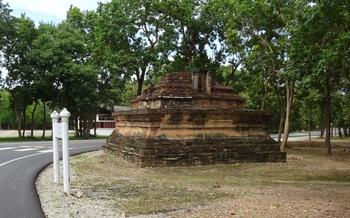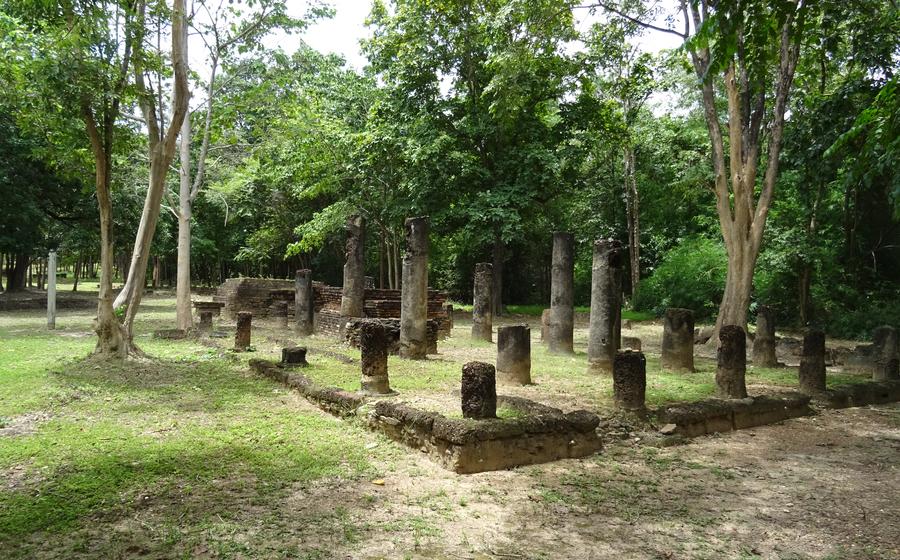
Wat Aranyik
- Wat Aranyik: A Temple of Serenity and Spiritual Significance
- The Unique Buddha Image of Wat Aranyik
- Exploring the Temple Grounds and Surroundings
- Immerse Yourself in the Local Culture
- Tips for Visiting Wat Aranyik
- Unlocking the Mysteries of the Temple's History
- Exploring the Symbolism and Iconography of the Temple
- Appreciating the Architectural Masterpieces of Wat Aranyik
- Discovering the Role of Wat Aranyik in the Community
- Unforgettable Experiences at Wat Aranyik
- Exploring Sukhothai Historical Park
- Indulging in Local Delicacies
- Exploring the Night Market
- Unleashing Your Inner Adventurer
- Insider Tip: Unveiling Hidden Gems
Wat Aranyik: A Temple of Serenity and Spiritual Significance
Wat Aranyik, nestled amidst the tranquil surroundings of Sukhothai Historical Park, is a sacred sanctuary that exudes serenity and spiritual charm. Its origins are shrouded in mystery, with legends attributing its founding to the revered hermit, Phra Ruesi, who sought solace and meditation in the serene forest. Over the centuries, Wat Aranyik has undergone several renovations and expansions, but it retains its essence as a place of worship, reflection, and spiritual enlightenment.
The temple's architectural design showcases the classic Sukhothai style, characterized by its elegant simplicity and understated beauty. The ordination hall, the heart of the temple, features a graceful curved roof adorned with intricate stucco decorations and delicate gables. The interior of the hall is adorned with Buddha images in various postures, each exuding a sense of tranquility and serenity.
Wat Aranyik holds immense religious significance for the local community. It serves as a center for Buddhist ceremonies and festivals, where devotees gather to pay homage to the Buddha and seek blessings. The temple's serene atmosphere fosters a deep connection with the divine, making it a popular destination for meditation and spiritual retreats.
The Unique Buddha Image of Wat Aranyik
At the heart of Wat Aranyik's spiritual significance lies a remarkable Buddha image, revered by locals and visitors alike. According to legend, the image was created by a renowned craftsman named Phra Ruang, who was guided by divine inspiration during its creation. The resulting masterpiece exudes an aura of serenity and compassion, capturing the essence of Lord Buddha's teachings.
The Buddha image at Wat Aranyik stands tall, radiating an ethereal presence. Its intricate features and graceful posture reflect the artist's exceptional skill and devotion. The image's serene countenance, with a gentle smile playing on its lips, invites contemplation and inner peace. The intricate details of the robe, adorned with delicate patterns, further enhance its captivating beauty.
For local people, the Buddha image holds immense religious and cultural significance. It is believed to possess sacred powers and is often the focal point of prayers and offerings. Devotees seek blessings, guidance, and protection from the revered image, which is considered a symbol of hope and spiritual fulfillment.
Throughout the year, various rituals and ceremonies are held at Wat Aranyik, centered around the Buddha image. These ceremonies offer opportunities for devotees to express their devotion and deepen their connection with the divine. The most significant of these rituals is the annual bathing ceremony, where the image is ritually cleansed with sacred water, accompanied by prayers and chanting.
Exploring the Temple Grounds and Surroundings
The temple complex of Wat Aranyik is a testament to the architectural prowess and spiritual significance that have defined Sukhothai for centuries. As you step through its gates, you'll be greeted by a serene atmosphere and a layout that invites contemplation and exploration.
The temple grounds are meticulously maintained, with manicured lawns, vibrant flower beds, and towering trees that provide shade and tranquility. The central courtyard is dominated by the main Buddha image, housed in an elegant viharn (assembly hall). Surrounding the viharn are several smaller chapels, each dedicated to a different deity or aspect of Buddhism.
Notable features within the temple grounds include a number of stupas, chedis, and salas. Stupas are bell-shaped structures that contain relics or sacred objects, while chedis are tall, spire-like structures that symbolize the Buddha's attainment of nirvana. Salas are open-sided pavilions that serve as places for meditation, relaxation, and community gatherings.
The natural beauty of the surroundings adds to the allure of Wat Aranyik. The temple is situated amidst lush greenery, with towering trees and tropical plants providing a sense of seclusion and serenity. The gentle sound of birdsong and the rustling of leaves in the breeze create a peaceful ambiance that enhances the spiritual experience.
Whether you seek a place for quiet contemplation, a deeper understanding of Buddhism, or simply an escape from the hustle and bustle of everyday life, the temple grounds of Wat Aranyik offer a sanctuary for the mind, body, and soul.
Immerse Yourself in the Local Culture
Wat Aranyik is not just a place of worship but also a vibrant center of local culture. Participate in religious ceremonies and festivals held at the temple to witness the colorful and vibrant traditions of Thailand. These events offer a unique opportunity to immerse yourself in the local way of life and connect with the community.
Interact with the friendly monks residing at Wat Aranyik and learn about their daily lives and practices. They are always eager to share their knowledge of Buddhism and Thai culture. Observe traditional Thai customs and practices, such as the wai greeting, which is a respectful way to show gratitude and respect.
Support local artisans and vendors by purchasing souvenirs and handicrafts. This not only helps to preserve traditional crafts but also contributes to the local economy. The night market near the temple is a great place to find unique souvenirs, such as handmade pottery, woven textiles, and silver jewelry, while supporting the local community.
Tips for Visiting Wat Aranyik
Visiting Wat Aranyik is a culturally enriching and spiritually uplifting experience, but it's essential to follow certain guidelines to ensure a respectful and enjoyable visit.
Appropriate attire is crucial when visiting the temple. Avoid wearing shorts, tank tops, or revealing clothing. Instead, opt for modest clothing that covers your shoulders and knees. Shoes should be removed before entering the temple's sacred spaces.
To fully appreciate the temple's serene atmosphere, aim to visit during the early morning or late afternoon when the crowds are smaller. This will allow you to immerse yourself in the tranquility of the surroundings and connect with the temple's spiritual essence.
Photography is permitted within the temple grounds, but it's important to be mindful of the sacred nature of the site. Avoid using flash photography or taking photos of monks or other visitors without their consent.
Wat Aranyik provides essential facilities for visitors, including restrooms and parking. These facilities are well-maintained and accessible, ensuring a comfortable and convenient visit for all.
Unlocking the Mysteries of the Temple's History
Wat Aranyik's history is shrouded in mystery and ancient legends. According to local folklore, the temple was founded by a hermit monk who discovered a sacred Buddha image hidden in the forest. The monk built a small shrine to house the image, and over time, the shrine grew into the magnificent temple complex that stands today.
Archaeological excavations at the site have revealed artifacts and inscriptions that shed light on the temple's rich past. These discoveries suggest that Wat Aranyik was once a thriving religious center and a pilgrimage site for devotees from across the region. The temple's strategic location along a major trade route contributed to its prominence and prosperity.
Historical records mention Wat Aranyik as a significant temple during the Sukhothai Kingdom. It is believed to have played a crucial role in the propagation of Buddhism throughout the kingdom and beyond. The temple's influence extended to neighboring countries, including Laos and Cambodia, where similar architectural styles and iconography can be found.
In the centuries that followed, Wat Aranyik faced periods of decline and neglect. However, it was never completely abandoned, and local communities continued to revere the temple and its sacred Buddha image. In recent years, the temple has undergone extensive restoration and conservation efforts, bringing it back to its former glory and attracting visitors from around the world.
Exploring the Symbolism and Iconography of the Temple
Wat Aranyik is a treasure trove of intricate symbolism and iconography, reflecting the profound influence of Buddhist cosmology and mythology. Every element of the temple's design, from the architecture to the artwork, is imbued with deep meaning and significance.
The temple's layout, for example, follows the principles of Buddhist mandalas, representing the sacred cosmos. The central stupa symbolizes Mount Meru, the mythical abode of the gods, while the surrounding chedis and Sala represent the four cardinal directions and the earthly realm.
Throughout the temple, visitors can find numerous depictions of Buddha, both in human and symbolic forms. The Buddha images are often adorned with intricate carvings and gestures, each conveying a specific meaning or teaching. For example, the Abhaya mudra, or gesture of fearlessness, represents Buddha's protection and reassurance, while the Bhumisparsha mudra, or gesture of touching the earth, symbolizes his enlightenment and connection to the world.
Other symbolic motifs found in the temple include lotus flowers, representing purity and spiritual growth; elephants, symbolizing strength and majesty; and Naga serpents, representing the protective power of water and the underworld.
By understanding the symbolism and iconography of Wat Aranyik, visitors can gain a deeper appreciation for the temple's religious and cultural significance. Each element of the temple's design becomes a window into the rich tapestry of Buddhist beliefs and teachings, offering insights into the minds and hearts of the people who created and revered this sacred space.
Appreciating the Architectural Masterpieces of Wat Aranyik
Wat Aranyik stands as a testament to the architectural genius and craftsmanship of the ancient Thai people. Its unique style seamlessly blends traditional Thai elements with religious and artistic influences, creating a harmonious and visually stunning masterpiece.
The temple's architecture boasts intricate carvings, delicate stucco work, and elegant spires that reach towards the sky. The use of traditional Thai materials, such as wood and brick, adds a sense of authenticity and warmth to the structure. The attention to detail is evident in every corner of the temple, from the ornate gables to the finely crafted Buddha images.
The temple's design showcases a harmonious balance between religious devotion and artistic expression. The layout of the temple complex, with its central stupa surrounded by smaller stupas and chedis, represents the Buddhist cosmology and the path to enlightenment. The intricate symbolism depicted in the temple's artwork, such as the lotus flower and the wheel of dharma, further reinforces the temple's religious significance.
Visiting Wat Aranyik is like stepping back in time and witnessing the artistry and ingenuity of the ancient Thai people. The temple's architectural masterpieces serve as a reminder of Thailand's rich cultural heritage and its enduring legacy in the world of architecture and art.
Discovering the Role of Wat Aranyik in the Community
Wat Aranyik is not only a sacred site for religious observances but also plays a vital role in the local community. The temple serves as a hub for religious ceremonies and festivals, bringing together devotees and residents from the surrounding area. During these events, the temple transforms into a vibrant gathering place, filled with the sounds of chanting monks, the aroma of incense, and the colorful spectacle of traditional Thai costumes.
Beyond religious festivities, Wat Aranyik is actively involved in providing education and support to the local community. The temple hosts educational programs for children, offering classes in Thai language, history, and Buddhist teachings. The monks also provide guidance and counseling to individuals seeking spiritual support or assistance during difficult times.
Moreover, the temple serves as a center for community development initiatives. The monks and temple committee organize projects aimed at improving the well-being of the local people. These initiatives may include healthcare programs, vocational training, and community service projects. By actively engaging with the community, Wat Aranyik contributes to the social and economic development of the area.
The temple's role in the community extends to preserving and promoting local culture. Wat Aranyik supports local artisans and craftsmen by providing them with a platform to showcase and sell their traditional handicrafts. The temple also hosts cultural events and workshops, allowing visitors to learn about and experience the unique traditions of the Sukhothai region.
Through its multifaceted role in the community, Wat Aranyik serves as a pillar of support, a source of guidance, and a beacon of cultural preservation. The temple's contributions to the well-being and development of the local people make it an integral part of the social fabric of the Sukhothai community.
Unforgettable Experiences at Wat Aranyik
My visit to Wat Aranyik was an unforgettable experience that left a lasting impression on my mind and spirit. The serene atmosphere, the intricate architecture, and the sense of spirituality that permeated the air created a truly magical experience.
One of the most memorable moments of my visit was witnessing the daily alms-giving ceremony. As the sun rose over the temple grounds, local people gathered to offer food and other necessities to the monks. The monks, dressed in their saffron robes, chanted and bowed in gratitude, creating a scene of peace and harmony.
Another highlight was exploring the temple's hidden corners and discovering the many beautiful Buddha images and murals that adorned the walls. Each image had its own unique story to tell, and I spent hours admiring the artistry and craftsmanship that went into their creation.
But beyond the physical beauty of the temple, it was the spiritual energy of Wat Aranyik that truly touched me. As I sat in meditation, surrounded by the sound of chanting and the gentle breeze rustling through the trees, I felt a sense of inner peace and tranquility that I had never experienced before.
My visit to Wat Aranyik was more than just a tourist attraction; it was a journey of self-discovery and spiritual enlightenment. I left the temple feeling refreshed, renewed, and with a deeper understanding of Thai culture and Buddhism.
Exploring Sukhothai Historical Park
Sukhothai Historical Park, a UNESCO World Heritage Site, is a treasure trove of ancient temples, ruins, and artifacts that offer a glimpse into the glorious past of the Sukhothai Kingdom. Located just a short distance from Wat Aranyik, the park is a must-visit for anyone interested in Thai history and culture.
Among the many notable temples within the park, Wat Mahathat stands out as a masterpiece of Sukhothai architecture. Its iconic central stupa, surrounded by a cluster of smaller stupas, is a symbol of the park and a reminder of the kingdom's power and influence. Wat Si Chum, another must-see temple, is home to a colossal Buddha image that exudes an aura of serenity and tranquility.
Sukhothai Historical Park is not only about temples and ruins; it's also a place of natural beauty and tranquility. The park's lush greenery, serene ponds, and ancient trees create a peaceful atmosphere that invites visitors to relax and contemplate the past.
To fully appreciate the park's wonders, it's recommended to set aside at least half a day for your visit. Start early in the morning to avoid the midday heat and crowds. Rent a bicycle or an electric cart to explore the vast park at your own pace, stopping at the temples and ruins that interest you most.
Be sure to visit the park's museum, which houses a collection of artifacts and exhibits that provide insights into the history and culture of the Sukhothai Kingdom. The museum is a great place to learn more about the park and its significance before embarking on your exploration.
Indulging in Local Delicacies
Sukhothai is not only renowned for its historical and cultural significance but also for its distinct culinary traditions. Embark on a gastronomic adventure and tantalize your taste buds with the flavors of Sukhothai cuisine.
Must-Try Dishes:
-
Sukhothai Noodles: These thin rice noodles are served in a savory broth infused with tamarind, peanuts, and bean sprouts.
-
Grilled Chicken: Succulent chicken marinated in a blend of local herbs and spices, grilled to perfection and served with a tangy sauce.
-
Khao Soi Sukhothai: A unique take on the classic northern Thai curry dish, featuring egg noodles, coconut milk, and a rich curry paste.
Recommended Restaurants:
-
Sukhothai Noen Lamyai: A popular choice for authentic Sukhothai dishes, known for its flavorful noodles and grilled chicken.
-
Krua Mae Sri Racha: A family-run restaurant serving traditional Sukhothai cuisine in a cozy and friendly atmosphere.
-
Jek Seng Restaurant: A local favorite for its delicious grilled chicken and papaya salad.
Street Food Delights:
-
Sukhothai Night Market: A vibrant marketplace where you can savor a variety of street food delicacies, including grilled meats, sticky rice, and sweet treats.
-
Wang Thong Market: A bustling morning market offering a wide selection of fresh produce, local snacks, and handmade souvenirs.
Navigating the Markets:
-
Embrace the Bargaining Culture: Don't hesitate to bargain with vendors for the best prices, but always do so politely and respectfully.
-
Ask for Recommendations: Locals are usually happy to share their favorite dishes and hidden culinary gems.
-
Be Adventurous: Don't be afraid to try new and unusual dishes. You might just discover your new favorite flavor.
Exploring the Night Market
As the sun sets and the sky transforms into a vibrant canvas of hues, Sukhothai's night market comes alive, pulsating with energy and excitement. Immerse yourself in the vibrant atmosphere as you stroll through the bustling stalls, each one a treasure trove of unique souvenirs and handcrafted goods.
Discover intricate silver jewelry, hand-painted pottery, and colorful textiles that showcase the artistry and craftsmanship of local artisans. Haggle with friendly vendors to find the best deals on souvenirs that will serve as lasting mementos of your time in Sukhothai.
Indulge in a culinary adventure as you savor the delectable street food offerings that line the market. From aromatic grilled meats to mouthwatering noodles and tropical fruits, the night market is a haven for foodies. Don't miss the chance to try Sukhothai's signature dish, "khao soi," a flavorful curry noodle soup that is a local favorite.
As you wander through the market, be sure to engage with the friendly locals who are always eager to share stories and insights about their culture. Experience the warmth and hospitality of the Thai people as you immerse yourself in the vibrant tapestry of local life.
Unleashing Your Inner Adventurer
Sukhothai offers a plethora of exciting outdoor activities for those seeking an adrenaline rush or a chance to connect with nature. Embrace the tranquility of the countryside by embarking on a leisurely cycling tour, where you can pedal through picturesque villages, rice paddies, and ancient ruins. Immerse yourself in the majestic beauty of the region by embarking on an elephant trekking adventure. These gentle giants will take you through lush forests, offering a unique perspective of the stunning landscape.
For those seeking breathtaking views, head to Khao Phang Kha, a scenic viewpoint that offers panoramic vistas of Sukhothai Historical Park. As the sun dips below the horizon, the sky transforms into a canvas of vibrant hues, creating a magical moment that will stay etched in your memory. If you're feeling adventurous, venture off the beaten path and explore the hidden waterfalls and caves that dot the region. These secluded spots offer a tranquil escape from the tourist crowds and a chance to reconnect with nature's serenity.
Insider Tip: Unveiling Hidden Gems
Beyond the popular temples, Sukhothai holds a treasure trove of hidden gems waiting to be discovered. Venture off the beaten path and explore lesser-known temples like Wat Chang Lom, renowned for its elegant chedis and serene atmosphere. For a unique perspective, climb to the top of Khao Phra Bat Noi, a hilltop temple offering panoramic views of the surrounding countryside.
Unleash your inner photographer at the Secret Garden, a hidden oasis filled with beautiful flowers, ponds, and sculptures. Capture stunning shots of the ancient ruins bathed in the golden light of sunrise or sunset. Don't miss the Sukhothai Night Market, a vibrant hub of local life where you can find unique souvenirs, savor delicious street food, and experience the infectious energy of Thai nightlife.
To delve deeper into the local culture, attend traditional festivals like Loi Krathong, when thousands of floating lanterns illuminate the night sky, or the Sukhothai Historical Fair, showcasing traditional Thai music, dance, and handicrafts. These events offer a glimpse into the heart and soul of Sukhothai's rich cultural heritage.
Engage with the friendly locals, who are always eager to share their stories and traditions. Learn about their way of life, their customs, and their deep connection to the land. Embrace the opportunity to experience the warmth and hospitality of the Thai people, creating lasting memories that will stay with you long after your visit.
